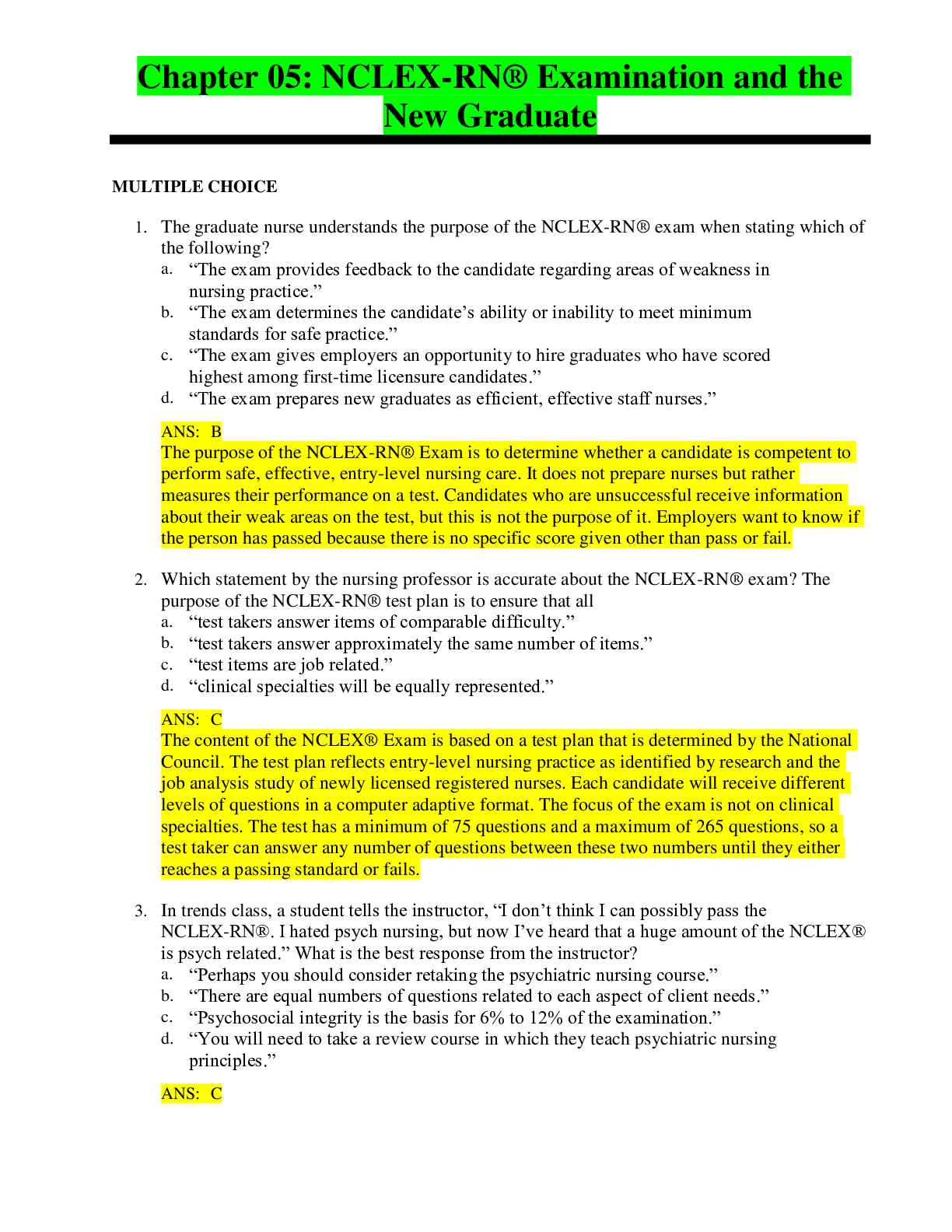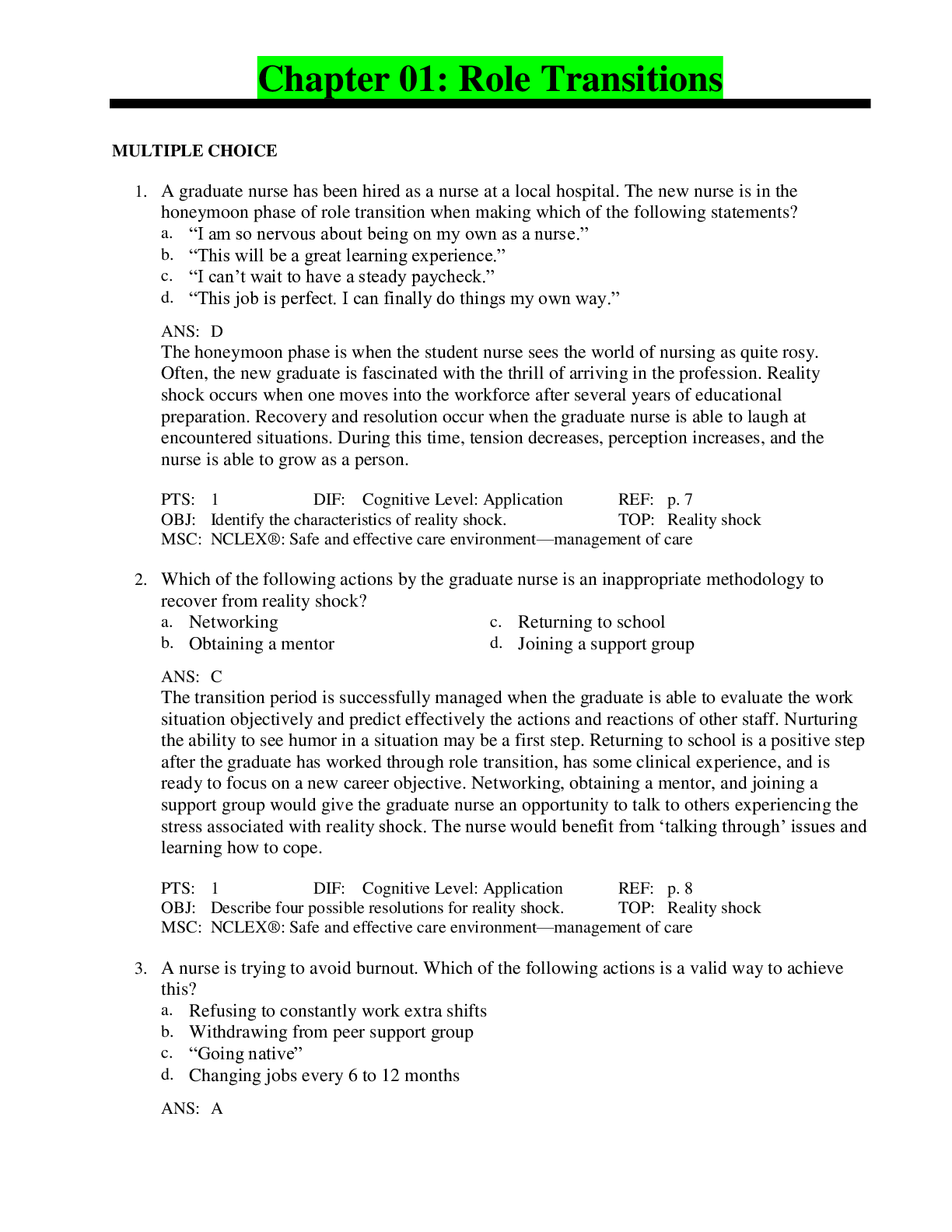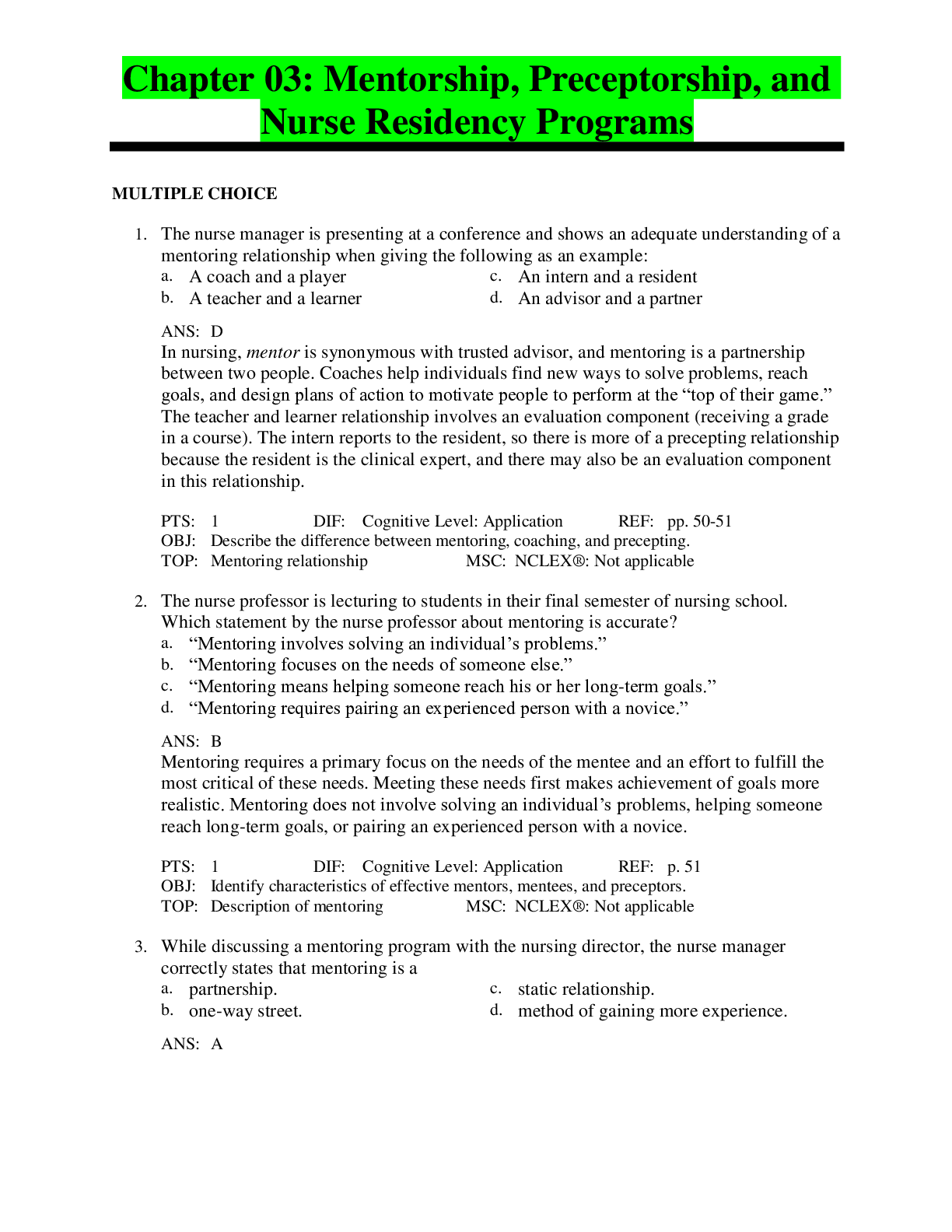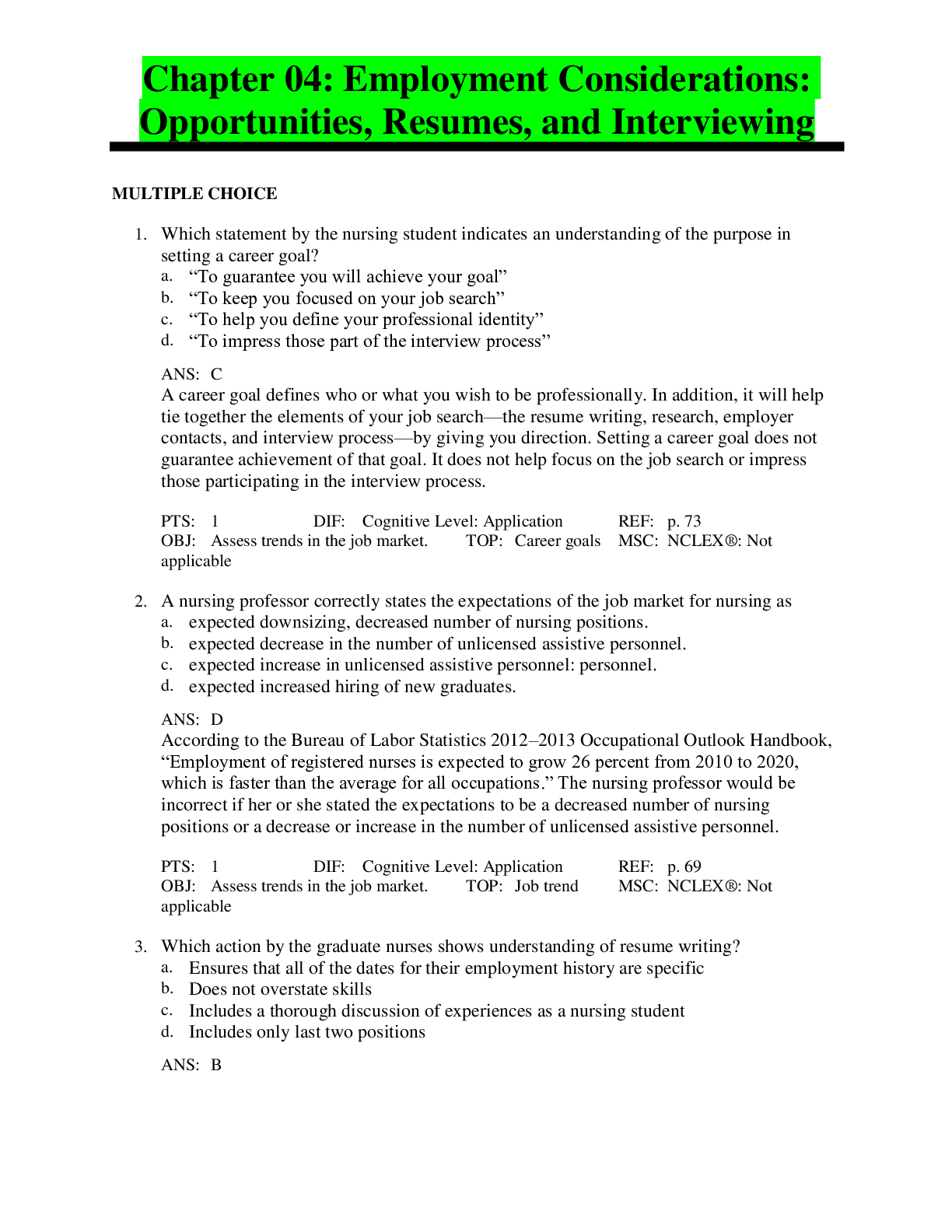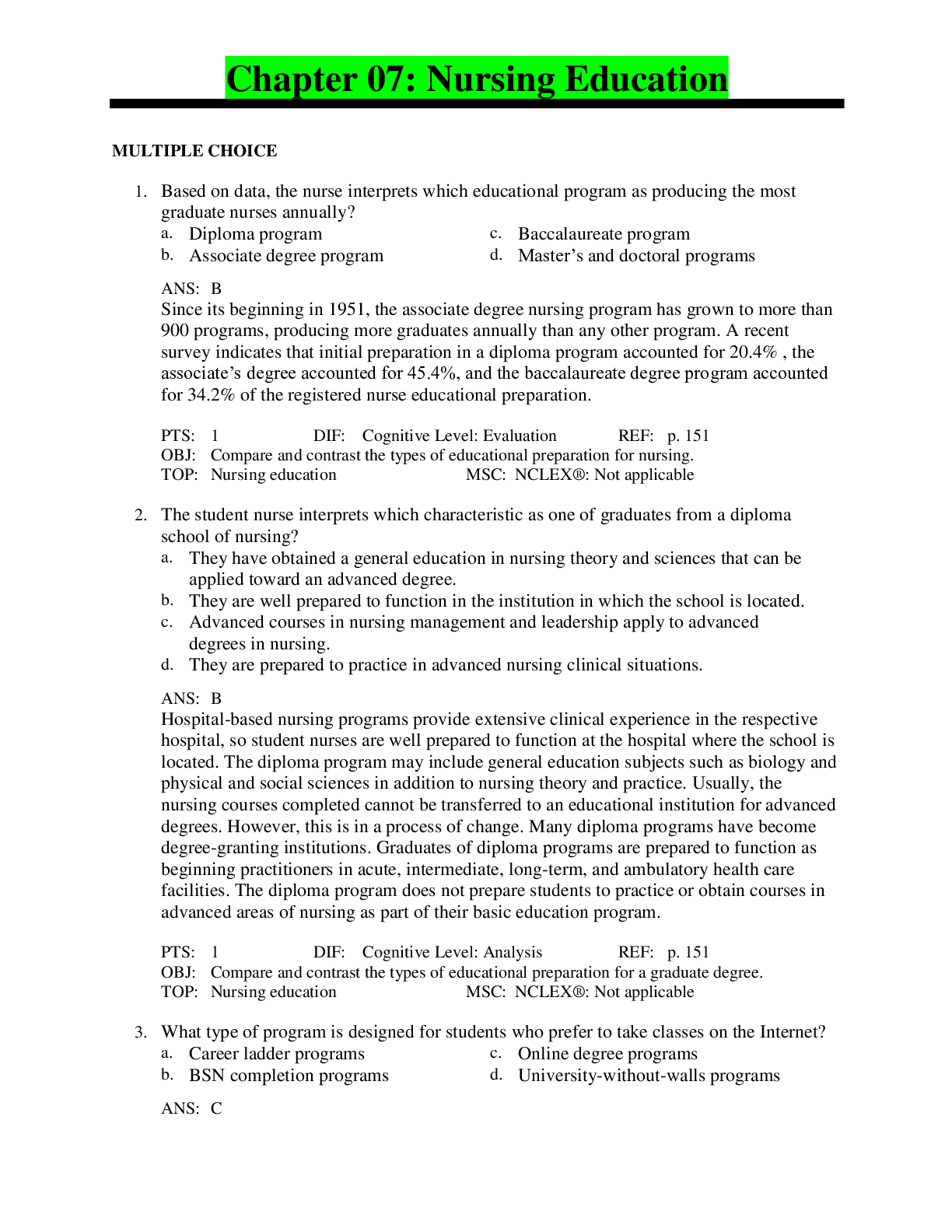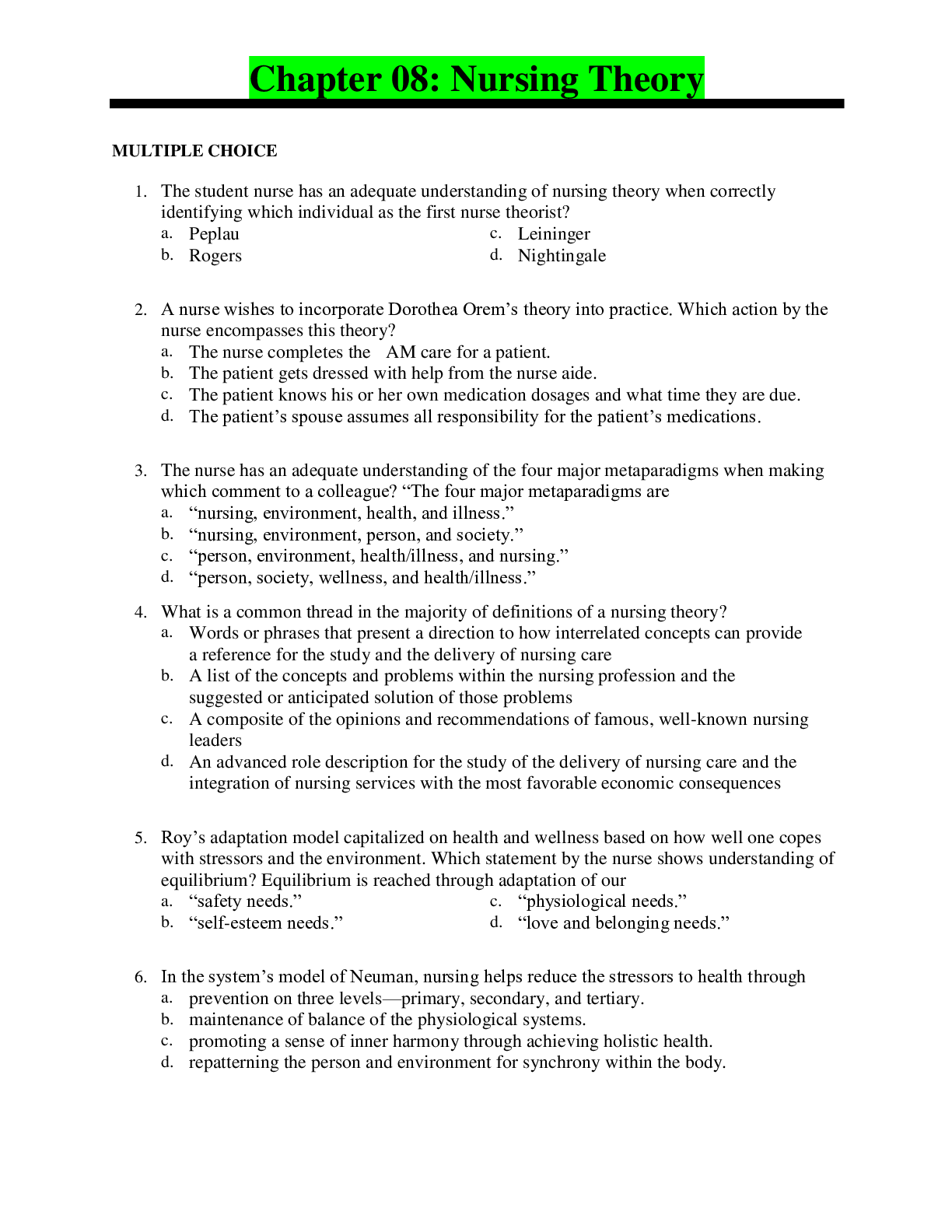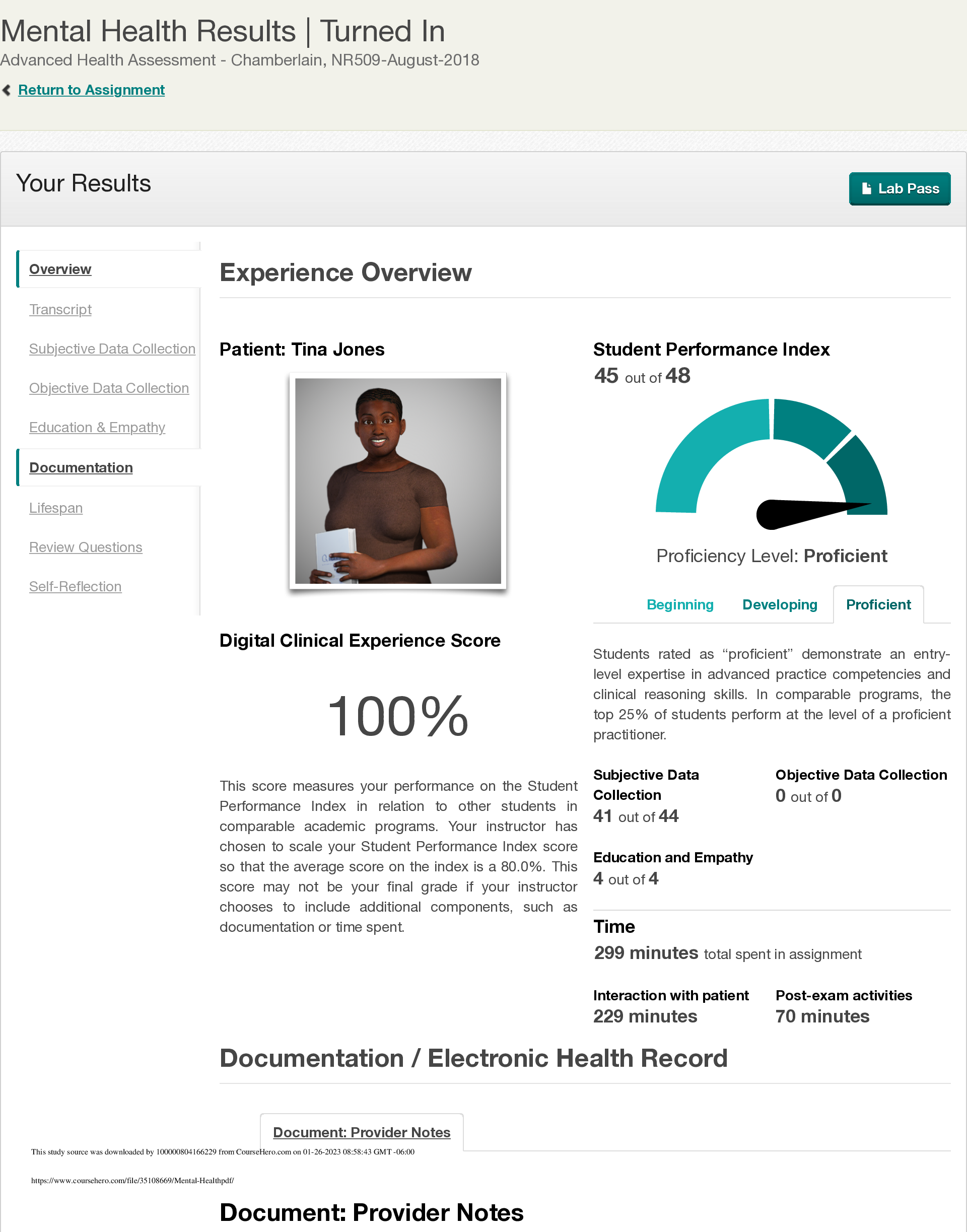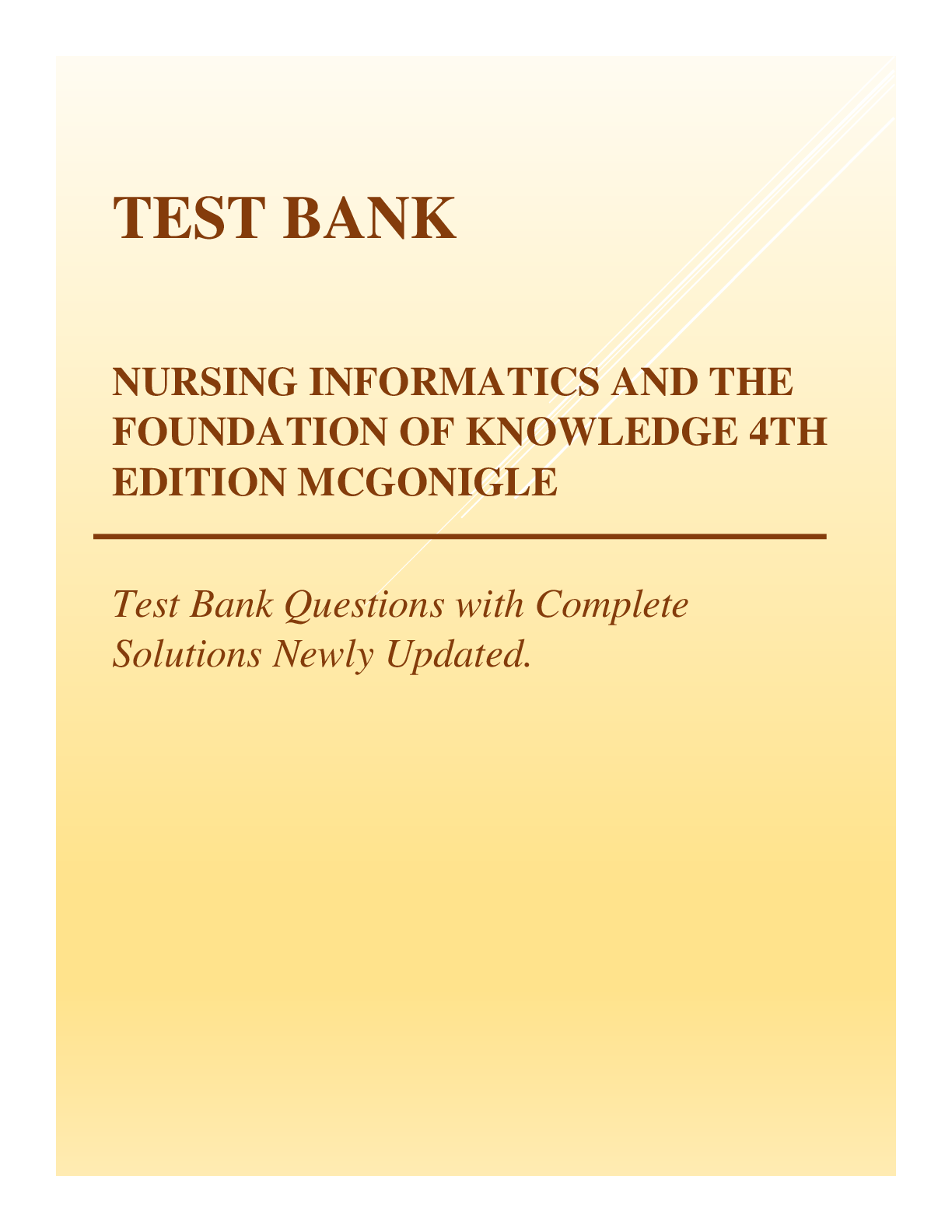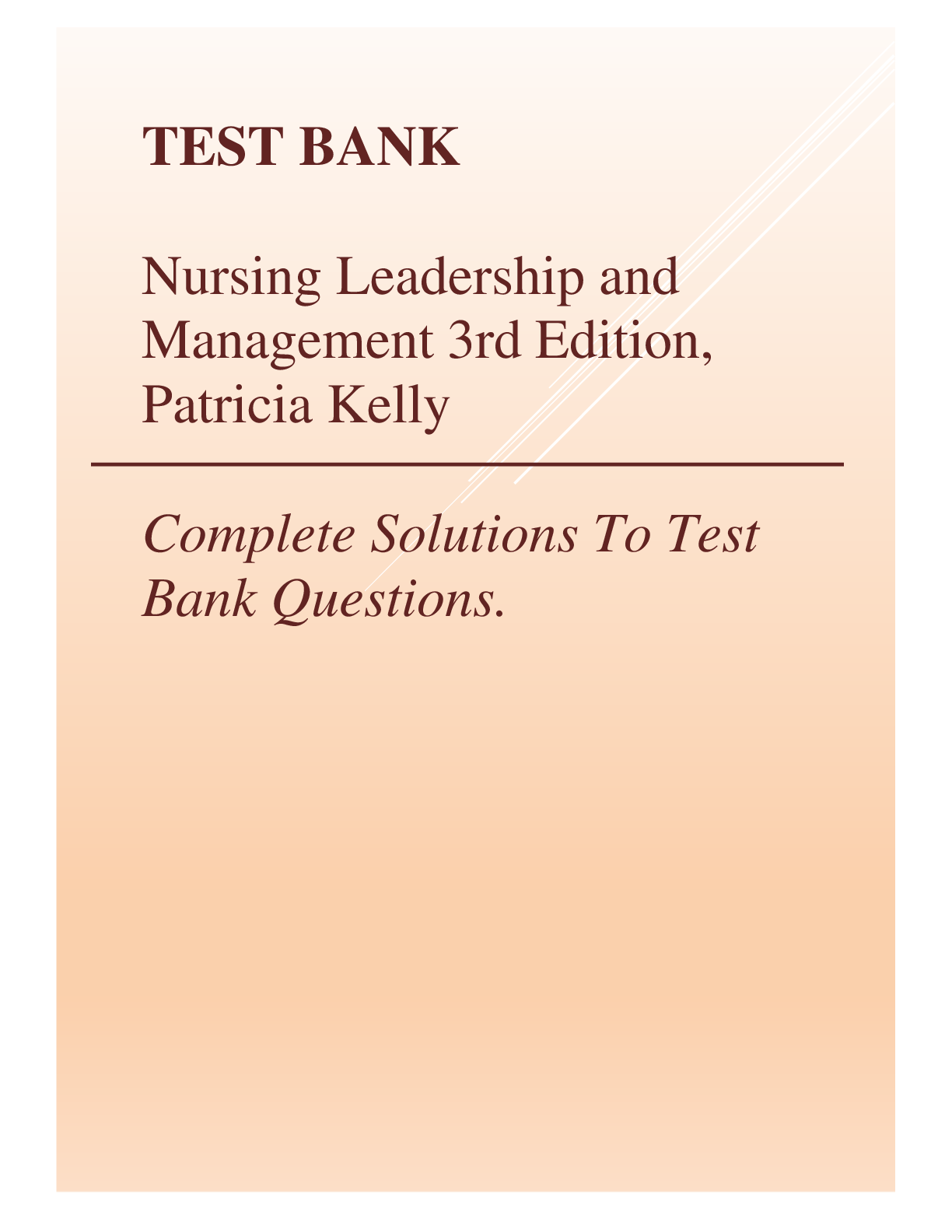*NURSING > QUESTIONS & ANSWERS > University Of Central Florida > Test Bank Nursing Today Transition Trends 8th Edition, JoAnn Chapter (All)
University Of Central Florida > Test Bank Nursing Today Transition Trends 8th Edition, JoAnn Chapter 10: Challenges of Nursing Management and Leadership
Document Content and Description Below
Chapter 10: Challenges of Nursing Management and Leadership MULTIPLE CHOICE 1. What is the most consistent concern of the nurse as manager? a. To develop long-range career goals b. To coordin... ate patient care while meeting the agency goals c. To maintain harmony within the agency d. To organize the subordinates to meet agency goals 2. What action would be an appropriate first step for the nurse to take toward becoming an effective manager? a. Learn how to effect and direct the change process. b. Assess individuals’ sources of power. c. Develop communication and interpersonal skills. d. Implement effective nursing care plans. 3. What do the responsibilities of the nurse manager include? a. Planning and organizing how nursing care can most effectively be delivered on the nursing unit b. Establishing the nursing care standards to be implemented on the unit c. Developing educational programs to assist staff to meet licensure requirements d. Assisting staff to adhere to organizational policies and procedures 4. The nursing staff on a busy unit enjoys autonomy and needs minimal direction for patient care. Which leadership style would be most effective on this unit? a. Democratic c. Laissez-faire b. Authoritarian d. Bureaucratic 5. Which statement best describes effective leadership by the nurse manager? a. Directs a staff nurse to modify his or her communication skills b. Fosters behavior changes in one staff member that have positive effects on the nurse manager and his or her peers c. Encourages behavior changes through the annual evaluation process d. Uses the group process to determine what behavior is distressing to staff 6. The nurse manager is beginning the process of problem solving. Which action should be taken first? a. Define the problem. c. Analyze the information. b. Gather information. d. Consider the alternatives. 7. A nurse is using the decision-making process. Which action should be taken first? a. Evaluate the outcome. c. Set the objective. b. Identify and evaluate options. d. Implement the options. 8. Which statement by the nurse shows understanding of the primary advantage in using the group process in decision making? The process a. “increases the time spent discussing alternatives.” b. “eliminates opposition to decisions by administrators.” c. “allows additional time for the planning process.” d. “promotes acceptance of the decision by the group.” 9. A nurse is interested in moving into a management position. Which action would assist with accomplishing this? a. Use of reward power c. Use of expert power b. Use of coercive power d. Use of legitimate power 10. A nurse is respected by peers for clinical skills and effective interpersonal relationships. The nurse has studied diabetic patient educational needs and consults with several units. What type of power does this nurse possess? a. Informational c. Reward b. Legitimate d. Expert 11. The nurse manager on a surgical unit receives notification that multiple victims of a plane crash will arrive at the hospital momentarily. What is the most appropriate leadership style to adopt in this situation? a. Authoritarian c. Laissez-faire b. Democratic d. Eclectic 12. The nurse manager tells the patient that he must eat his breakfast before getting out of bed. What type of power is the nurse manager using? a. Legitimate power c. Coercive power b. Expert power d. Referent power 13. Which statement by the staff nurse shows adequate understanding of the nurse manager role? The nurse manager: a. “is given information and power through an official position.” b. “coordinates group activities toward a common goal.” c. “is responsible for developing goals to be accomplished.” d. “selects and assumes a role among a group of peers.” 14. The nurse manager is giving a presentation on the disadvantages of democratic leadership in group functioning. Which statement shows an understanding of this type of leadership? a. “Requires more time and effort to make decisions and accomplish goals” b. “Discourages participation from quieter members of the group” c. “Increases the possibility of “scapegoating” or argumentative behavior” d. “Is difficult to control the outcomes and decisions of the group” 15. A nurse is unhappy about the way medications are being administered on the unit. What does the nurse need to do first to facilitate a change in the process? a. Initiate a new method starting with assigned patients. b. Discuss concerns with fellow nurses. c. Develop a better method to administer the medications. d. Inform the charge nurse of how it can be done better. 16. A nurse wants to implement a change in the work environment. Which of the following actions would be the most important thing to do? a. Ask for suggestions from peers working in other institutions. b. Explain to coworkers how a different plan would work better. c. Seek input from coworkers from the beginning. d. Incorporate all suggestions into the plan before implementing. 17. If many complaints arise about a newly developed procedure, what is the best way to handle them? a. Discontinue the change because it is not working. b. Persuade a few friends to talk positively about it. c. Consider the complaints as indications that change is being resisted. d. Analyze the complaints and alter the plan as needed. 18. What types of changes in management can be anticipated with the introduction of generations X and Y to the nursing work force? a. More flexible work time and increased personal responsibility for work outcomes b. Increased loyalty to the institution and the need for a well-defined work environment c. Increased interest in the goals and needs of the institution d. Increased structure within the nursing environment to more effectively predict outcomes 19. The nurse understands that having a stand-up meeting versus the traditional (sitting at a conference table) meeting takes less time to come to a decision based on which of the following ideas? a. Contingency-style leadership b. Evidence-based management protocols and interventions c. Autocratic management style d. Presence of a clinical nurse leader (CNL) 20. A nurse manager has an adequate understanding of their nursing role when making which of the following statements? a. “A manager selects or assumes a role.” b. “I have the same function as a floor nurse.” c. “I have the same authority as the director of the hospital.” d. “I was appointed to my role.” 21. Which of the following actions is consistent with a nurse leader? a. A nurse who encourages staff to give excellent patient care b. A nurse who performs chart audits on her staff c. A nurse who writes yearly staff evaluations d. A nurse who gives pain medication to an assigned patient 22. A nurse manager has received a report that indicates the infection rate on the unit has gone up by 25% in the past month. The control phase of management requires that the nurse manager take action. What should the nurse manager do? a. Post the report for staff to read. b. Pull a couple of the nurses aside and discuss the issue with them. c. Send an email out to the staff with information regarding upcoming infection prevention conference. d. Provide a mandatory handwashing in-service to all staff. 23. Which of the following actions by the nurse manager would indicate an autocratic management style? a. Allows staff members to make most of the decisions b. Makes most of the decisions without input from the staff members c. Exerts little control over staff d. Emphasizes effective group functioning 24. The nurse manager identifies which of the following as the most critical step in problem solving? a. Brainstorm all possible solutions. c. Evaluate possible solutions. b. Identify the problem. d. Choose a solution. 25. Which action by the nurse indicates placement in the unfreezing phase of Lewin’s Change Theory? a. The nurse reconsiders what has caused themself to be resistant to change. b. The nurse begins the process of implementing change. c. The change has become routine. d. The change is permanent. MULTIPLE RESPONSE 1. Which of the following actions is consistent with a manager? (Select all that apply.) a. Planning the agenda for a staff meeting b. Directing nurse assistants in how to divide up patient care assignments c. Organizing a group of nurses to present a topic at a staff meeting d. Giving blood at the local hospital blood drive e. Assume control of the guidelines for how hourly rounding will work on the unit 2. A nurse manager is in the planning phase in a new job. Which action shows this? (Select all that apply.) a. Developing goals that reflect the mission and vision of the organization b. Defining strategies to meet the mission and vision of the organization c. Providing direction for staff to perform the work of the organization d. Retaining accountability for all work completed by the staff e. Planning for contingencies which may interfere with the work of the organization 3. Which of the following statement by the nurse reflect transformational leaders? (Select all that apply.) a. Lifelong learners b. Courageous change agents c. Slow to change d. Value-driven visionaries e. Hesitant to follow 4. Which of the following describes reward power used by the nurse manager? (Select all that apply.) a. A nurse manager who uses fear of consequences to motivate staff b. A nurse manager who uses salary increases to motivate staff c. A nurse manager who is perceived as an expert due to specialized knowledge d. A nurse manager who is well liked by the majority of staff e. A nurse manager who has information that others need to perform their jobs MATCHING Match the leadership theory with the appropriate description. a. Development of trust in relationship; uses democratic concepts of management and views the tasks to be accomplished from the standpoint of a team member b. Holds power and control over followers by providing incentives when the followers respond in a positive way to the leader’s vision and the actions needed to reach that vision c. Situation is analyzed and leadership style is selected that will best address issues d. Process in which leader and followers work together in a way that changes or transforms the organization, the employees or followers, and the leader e. Leadership is flexible enough to address varying situations f. Needs to look at systems, such as those in health care organizations, as patterns of relationships and the interactions that occur among those in the system 1. Complexity theory 2. Transformational leadership 3. Contingency leadership 4. Transactional leadership 5. Situational leadership 6. Interactional leadership [Show More]
Last updated: 1 year ago
Preview 1 out of 12 pages
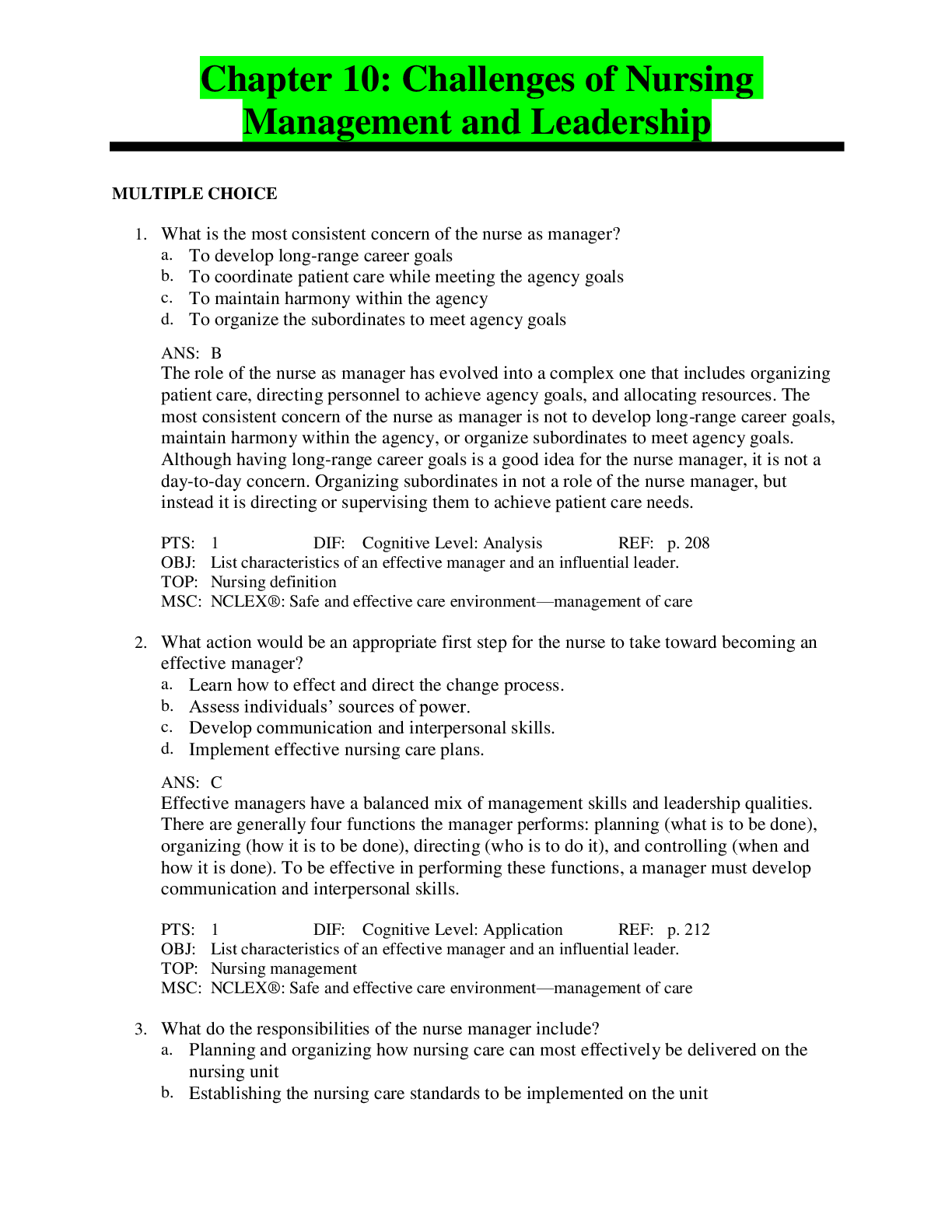
Buy this document to get the full access instantly
Instant Download Access after purchase
Add to cartInstant download
We Accept:

Reviews( 0 )
$8.00
Document information
Connected school, study & course
About the document
Uploaded On
Apr 24, 2020
Number of pages
12
Written in
Additional information
This document has been written for:
Uploaded
Apr 24, 2020
Downloads
0
Views
78













